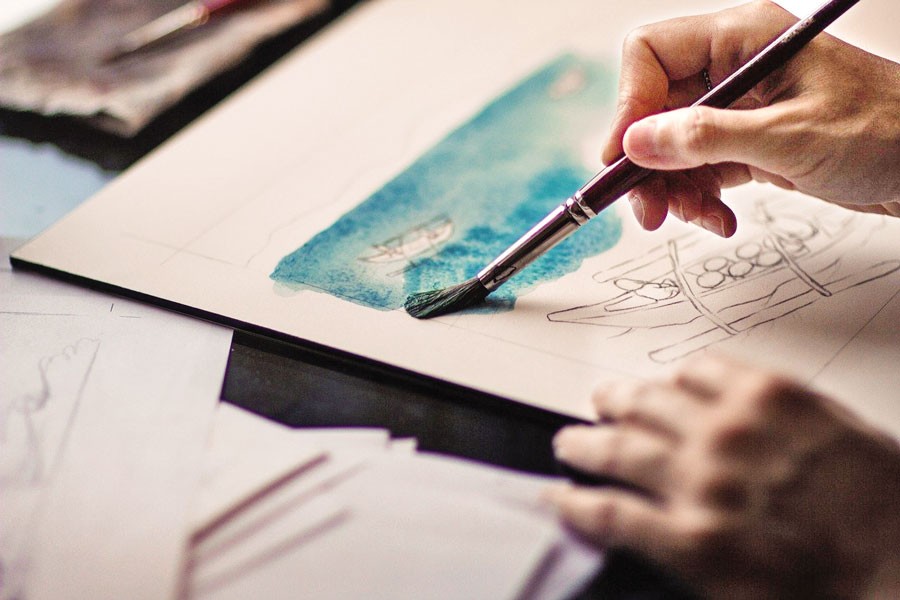
Published :
Updated :

The first hiccup of an artist's life comes from their own family. Any form of artistry is often meant to stay as nothing more than an extracurricular activity in resumes. And attempting to place art as a career option unleashes Athena as the goddess of war, rather than wisdom and crafts. As it is believed among the elders that art feeds the soul, but often not the stomach.
If a young artist receives wholehearted support from their family, chances are that they are not 'Desi.' In Bangladeshi households, sometimes, even doctors and engineers get pitiful gazes if they are not BCS cadres yet. Nevertheless, a creative craving cannot be buried under unjustified responsibilities called parents' dreams and social status. Novia Novely, a student of graphic design at Dhaka University's Faculty of Fine Arts, has chosen to stick with her own contentment, as painting has given her a keen sense of purpose since childhood.
"I used to have trouble studying without digital tablets, but could not face my parents to buy the necessities as they didn't approve my career choice at first," she resonates with most young artists of Bangladesh. "But once you get a little support like every other career choice, art can give you both stability and expedition."
Another student of Dhaka University's Department of History of Art, Anadiny Mogno, shares a similar yet different experience as an artist. She grew up with a love for art and animations. Even though her family did not approve of her career choice initially, they gave in eventually and started to give her full support after she had begun to prove herself.
Mogno offers her experience of being an artist at a corporate office like Drik. She says, "Digital art has an expanded demand now. Every organisation needs artists for its designs, posters, animations, etc. That's why most students of art turn to graphic designing."
Although digital art is gaining appreciation, Mogno indicates the other side of the coin as well. "All the demand that we see is mostly from overseas. Native companies still do not offer many requests for digital art," she noted. She has prepared illustrations for a children's book as a freelance artist and explains how freelancing sites offer extensively more opportunities than native companies. However, the pandemic has pushed a halt to her corporate life. She's hopeful for a stable career as a museum curator and freelance illustrator in the near future when everything is normal again.
Fabliha Nawar is a student of English and Humanities at BRAC University, but everyone following her on social media knows her as an artist who paints on paper and her face. Despite being an artist at heart, she had chosen to major in English as a result of a bargain with her family that hoped she would become a doctor. In the end, she had accepted to paint with poetry and write with colours.
"I'm grateful that I have enough privilege to fuel my passion even as a hobby," says Fabliha. When asked if she wants to paint as a professional, she denies saying "Just like my parents, I don't find career opportunities for a traditional artist much appealing in Bangladesh yet." She also mentions with a positive accord that the demand for fine arts is slightly better than before, as there are vast opportunities to translate traditional art into digital. Although that alone does not increase the request for certain genres of artistry, countless other paths remain valid.
The young generation is getting more interested in Kitsch art and popular art replicas such as Van Gogh, Vermeer, Munch's works. Because of that, hand-painted wearable and showpieces are opening paths for creative startups.
Unlike digital artists, work opportunities for handicrafters are significantly low. They often are left with limited options of starting a personal business, becoming a lecturer or waiting for an invitation to private, and sometimes government-funded projects. Such opportunities are as rare as finding a rickshaw artist nowadays. However, being an artist offers the flexibility of keeping a Plan B.
Even though it seems unrealistic for Bangladesh to grow into an artist-friendly nation all of a sudden, a career as an artist is not a complete mirage today. Private art and animation studios are somewhat on the rise, leaving artists hopeful for days without insecurity. Freelancing or creating branded businesses leave endless opportunities as well.
It is harmless to say that Japanese Manga and Anime spark many youths' dreams of working as full-time artists. However, unlike Japan, Bangladesh does not have a proper industry contributing solely to animations and comics yet. Perhaps Bibiya and Behula's animated music videos would inspire an art revolution in Bangladesh and save artists from episodes of existential crisis.
Tisha is a student of English at Shahjalal University of Science and Technology. mehenaz.sultana.tisha@gmail.com


 For all latest news, follow The Financial Express Google News channel.
For all latest news, follow The Financial Express Google News channel.